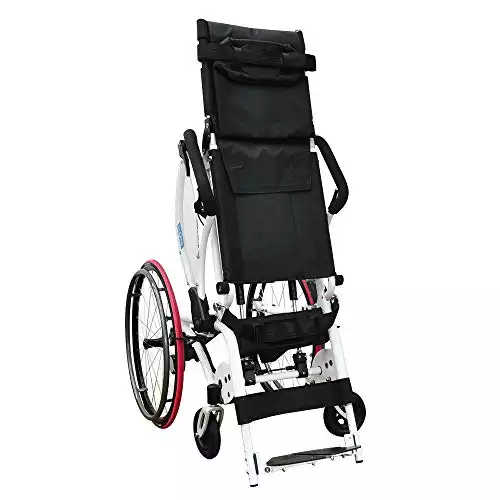In a Nutshell:
Leo II is a fantastic chair featuring some uncannily good engineering and the only manual standing wheelchair we’ve come across to date. It is recommended for users who weigh no more than 265 pounds, have a need for a standing chair, have the upper body strength to use the manual standing feature, and be able to afford it. That’s a long list, which makes this very much a niche product. An amazing one, but a niche product nonetheless.
Affordability
Durability
Maneuverability
Usability
Brand Reliability*
Overall Rating
3.8/5
Benefits
- Exceptionally Well-Implemented Manual Stand Feature
- Superb Design
- Minor Quibbles
Drawbacks
- High Price
- Limited Weight Capacity
- Market Appeal Limitation
Recommended For: Users who weigh no more than 265 pounds, need a standing wheelchair, and have the upper body strength to use the manual standing feature.
Are you tired of struggling against the limits that your mobility issue imposes on you? Have you been searching for a wheelchair that will give you more freedom and help you break those limits? If you answered yes to the questions above, then you’re going to love reading our Leo II wheelchair review even if you ultimately can’t afford it.
There’s no other way to say it; this is an amazing chair. It’s the only standing wheelchair we’ve come across that doesn’t rely on electric motors to assist with the standing function, which means it can serve as an important part of ongoing physical therapy. It also gives you vast new freedom and flexibility.
In the sections below, we’ll take a deep dive and explore everything the Leo II lightest manual standing wheelchair has to offer. We’ll also be quick to point out its downsides (spoiler alert: The big one is that it’s really expensive), so you’ll have all the information you need to decide for yourself if this is the chair you’ve been looking for.
If that sounds good to you, read on, and let’s take a closer look!
An Overview of the Leo Standing Wheelchair
We might as well pull the Band-Aid off right away, so here’s the bad news. The first thing you should know here in our Leo II wheelchair review about the model is that it’s expensive.
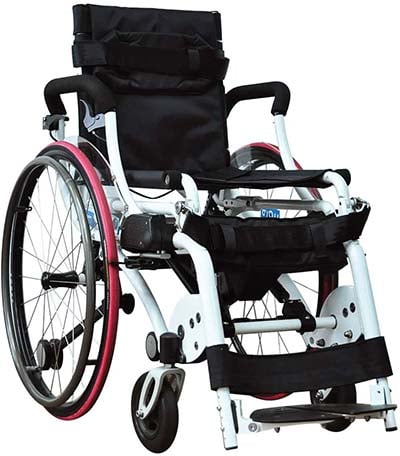
No, really, really expensive. As in, take out a loan to buy one, expensive. As in, you could get a decent used car for what you’ll pay for one of these expensive.
Right up front then, unfortunately, the hefty price tag puts the Leo II out of the reach of many people who may want one and many of the people it could genuinely help. That’s unfortunate, but even if you don’t think you can afford one, we urge you to keep reading because it really is an amazing design, and you’ll definitely want to put it on your wish list!
Honestly, the only real downsides to this chair are the price and the fact that it’s offered by a smallish Malaysian company that doesn’t have great brand recognition.
Everything else about it is amazing, and it’s clear that although Foldawheel doesn’t have a big brand presence here in the US, the company knows a thing or two about designing wheelchairs because the engineering that went into making the manual standing feature is superb.
The easiest way to understand how it works is to watch a video of the feature in action, but we’ll try to do the process justice here. If you want to stand up in the chair, you lock the wheels in place, then release a catch on the seat and armrests.
You use your arms to lift yourself up to a partial standing position, and the seat moves up providing support. Once your arms are at full extension, you pull up on the armrests, bringing them back above the new, higher seat position. This process is repeated 2-3 times until you’ve pulled yourself into a standing position.
To sit back down, the process is simply reversed. A flick of a lever changes the direction of the armrests and seat, allowing your body weight to gently lower the seat down. You then apply pressure to the armrests to bring them down with you and repeat until you’re in a seated position again, at which point you can unlock the wheels and use the wheelchair normally again.
It’s fabulous, and it completely negates the need for an elaborate (and often noisy) series of lift motors to provide that function.
It’s also great if you want to incorporate your wheelchair into ongoing physical therapy because, in addition to offering you a level of freedom and flexibility that few other wheelchairs can match, it also provides an exceptional, low-intensity workout. That’s a win-win!
The company describes their product as sporty, but we think that’s overselling it. It could be sporty if it had mag wheels and a racing-style body. In its current form, it’s certainly not an ugly chair, but we feel that it falls short of being truly sporty. Most people won’t take issue with its looks, though.
Before we can say more than that, we need to pause for a moment to take a look at the raw numbers that drive and define the Leo Standing wheelchair. Here are the basics:
- Overall Product Dimensions: 40” x 22-26” x 35-39” (depending on seat size selection)
- Seat Dimensions: 14,” 16,” or 18” W x 14,” 16,” or 18” D
- Seat to Floor Height: 20.5.”
- Wheel Size: 23.5” rear, with 6” casters
- Seatback Height: 15.7” – 19.6.”
- Footrests: Adjustable length
- Ground Clearance: 2.”
- Chair Weight: 61.5 pounds, 63.7 pounds, or 66 pounds
- Maximum Supported Weight: 265 pounds
As you can see, this is a delightfully adjustable chair. You can select from three different seat width/depth configurations, and both the seatback and the leg rests adjust.
Unfortunately, the seat height is stationary, and the arms don’t swing away and aren’t removable.
They can’t be because they play a pivotal role in the manual standing function. In any case, you’ll want to take a careful measurement of your leg length to make sure that the seat height is acceptable before committing to purchase.
The only other things to note are that the chair doesn’t have a lot of ground clearance and that it doesn’t support a lot of weight.
The former issue paints this chair as one primarily designed for use at home or in urban environments where you don’t have to contend with large obstructions on the ground as a general rule. As such, the low ground clearance usually isn’t a deal-breaker for more.
The weight limit, though, is another matter.
Although there’s no set standard, generally speaking, most wheelchairs on the market today support at least 300 pounds, with chairs designed for big and tall folk supporting more, and often significantly more.
Unfortunately, this model doesn’t quite rise to the 300-pound average. Obviously, that’s not an issue if you weigh 265 pounds or less, but it makes this model a complete non-starter if you happen to weigh more than that, which further narrows the already narrow market for the Leo standing wheelchair.
Adjustability and Comfort of Leo 2 Standing Wheelchair
We’ve already covered the wide array of adjustable features to be found on the Leo 2 Standing wheelchair, so we won’t repeat them here, which will make this a relatively short section.
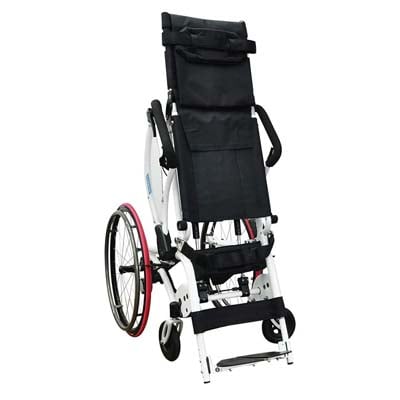
The only real disappointment, in our book, is that the seat height isn’t adjustable. We’re honestly not sure why. It seems like it would be a fairly straightforward addition, and given the already high price of the chair, the slight increase in cost to add that feature would barely be noticed. Plus, it would align the seat height with just about every other feature of the chair that is adjustable.
It’s better than average on the comfort front, but that’s not saying much, given that the bar is pretty low. A great many wheelchairs on the market simply have vinyl upholstery stretched across the frame, which is not breathable at all and gets hot in short order.
You’ll find that here too, but there is a nominal amount of padding that provides a more comfortable seating experience than you might expect, at least for shorter periods of time.
On the one hand, that could be seen as a plus. You’re apt to get hot if you spend too much time sitting in it (it’s definitely not a chair designed for lounging), which will likely prompt you to use the manual stand feature now and again.
On the other hand, it would be nice to be able to sit for a while in greater comfort. Fortunately, that’s easily addressed as just about any third-party seat and seatback cushion will work here, so you can customize the level of comfort to your heart’s content. Our only complaint here is that given the price of the chair, you shouldn’t have to buy added cushioning separately, which is a bit of a disappointment.
Extras and Options of Leo II Standing Wheelchair
This is one of our favorite parts of our Leo II Standing wheelchair review because Foldawheel did a great job on this front. First, we have to count the standing function itself as an “extra” given that it’s just not something you find on most wheelchairs on the market today.
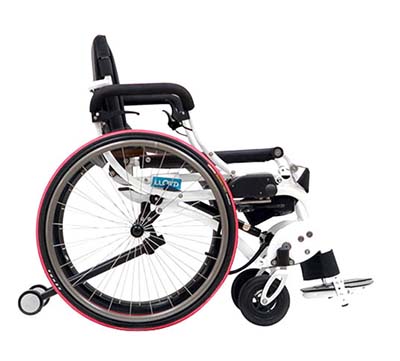
In addition to that, virtually everything about the chair is adjustable (except, as mentioned, the seat height). The leg length adjustment actually adds therapeutic value to the manual stand function, which is awesome in its own right.
If that’s not enough, though, you’ll find standard anti-tippers and a variety of harnesses and safety belts included. We love this. Seatbelts aren’t included on nearly as many wheelchairs as we’d like, and even when they are, most of the time, you just get a simple lap belt.
Here, you get a variety of leg, calf, and knee straps too, which, when you think about it, is excellent given this chair’s main feature.
On top of all that, Foldawheel offers push handles, a USB adapter, a back brace, and a mini air pump as optional equipment. The aftermarket is also brimming with possibilities. If you want to customize your chair even further, that’s certainly possible.
Overall, we like the options and accessories on offer, but again we’ll raise our quibble of lackluster padding. While we understand that this chair wasn’t designed for lounging, at the price they’re selling it for, more padding (perhaps even memory foam) would not have been out of order.
Portability & Ease of Use
If you’re looking for a wheelchair that maximizes portability, this isn’t the one you want. Having said that, for a standing wheelchair, it’s amazingly portable. As the company points out, it’s the lightest standing wheelchair on the market today.
We absolutely believe that.
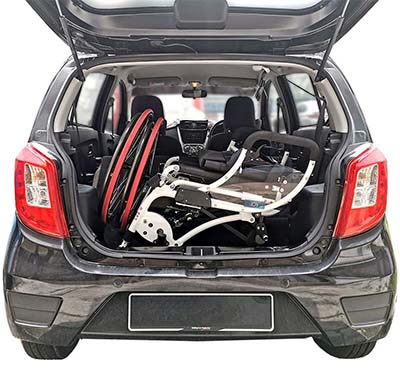
While the Leo II lightest manual standing wheelchair is certainly not a featherweight, it is light enough that most people won’t have major issues folding it up and stashing it in the trunk of a mid-sized sedan. Of course, if you own an SUV, truck, or van, storage is even easier.
You will pay a bit of a premium taking the Leo 2 standing wheelchair with you on a plane, but you shouldn’t have any difficulties doing so.
You’ll want to call the specific airline you’re flying with before you head that direction, just to make sure, but there’s no reason that any airline should balk at letting this chair on the plane. Most objections stem from batteries, and this chair doesn’t have any of those.
Overall then, we rate it as above average in terms of portability.
In terms of ease of use, it is admittedly a bit more difficult to use than a conventional wheelchair because you have a few additional features to master. The manual standing feature is so well designed, though, that you’ll be able to use it in a matter of minutes. Kudos to Foldawheel for an excellent design!
Pros & Cons of Leo II Lightest Manual Standing Wheelchair
This is an easy section of our Leo lightest standing wheelchair review to write because if you decide to buy this chair, it will be for the exceptionally well-implemented manual stand feature. There’s just no other reason to spend thousands of dollars on this chair except for that.
Our minor quibbles about padding and the lack of seat height adjustment aside, this is a superb chair from top to bottom. Its only real points of weakness are its fantastically high price and the fact that it only supports 265 pounds of user weight.
Unfortunately, those are two significant drawbacks, and taken together, they sorely limit the market appeal of this model.
Leo II Wheelchair Review Conclusion
In our view, here’s a quick portrait of the ideal user for this chair:
- Someone who is specifically in the market for a manual standing wheelchair and wants to incorporate their chair into their ongoing physical therapy regimen.
- Someone who is healthy enough and has enough upper body strength to make good, regular use of this model’s main feature.
- Who has a few thousand dollars to spend on a wheelchair.
- Finally, this chair requires someone who weighs 265 pounds or less.
We’d say here in our Leo II wheelchair review that if all four of those bullet points describe you, then this is hands-down the wheelchair you want. No question.
Most of those bullet points, however, are binary. The first one you run across that doesn’t apply to you will probably be a deal-breaker. On that basis, awesome chair or no, we can only give it a provisional recommendation. It’s very much a niche product, but for the right user, it’s absolutely amazing.
References & Resources:
- Mom Starts Nonprofit Working to Redefine Air Travel For Wheelchair Users Like Her Son, northjersey.com
- Air Travel For People Who Use Wheelchairs, Council of Canadians With Disabilities
- Reinventing the Wheelchair: Making Air Travel More Accessible to Disabled Passengers, Aviation Business News
- Air Travel and Accessibility For People With Disability, People With Disability Australia
- Air Travel For Wheel Chair Users, Disabled Travel Advice
